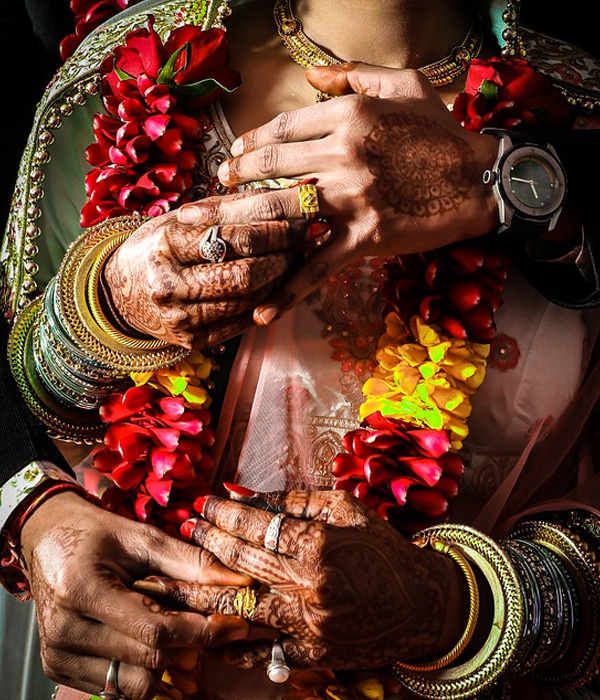
Wedding Ceremony
The marriage ceremony is a very sacred and auspicious occasion.It marks the start of a new friendship, a new family and the first big step into responsibility.
The ceremony dates back to thousands of years ago and many of the rituals are very much alive today and their meanings bring out the essence of Hindu Philosophy.
The Hindu Marriage is regarded as a union of two souls to help each other in the spiritual evolution.
Wedding Ceremony
Arrival of Groom (Jaan)
The Groom arrives at the venue accompanied by his family and friends who are singing and dancing in celebration of his weddings.
Varberu
The Bride’s sister carries a decorative coconut on her head and welcomes the groom as he arrives with his jaan. The bride’s sister gives her blessings to the groom by applying a chandlo (vermillion powder and rice) to his forehead.
Pokhwanu
The bride’s mother carries out the Pokhwanu. She applies an auspicious red mark (Chandlo) on the groom’s forehead and tries to pinch his nose to playfully remind him that he has come to door, to ask for her daughters hand in marriage and ask if he is prepared to make a life –long commitment to her daughter. The groom then steps on a samput (earthen pot) with his right foot and crushes it .The groom is then lead towards the mandap by the bride’s parents.
Ganesh Poojan
All auspicious Hindu ceremonies begin by inviting Lord Ganesh (God of Wisdom, prosperity and fortune) to the occasion, for he is said to disperse darkness, ignorance and removes obstacles along the way. The groom takes his place in the Mandap and awaits the arrival of the bride.
Arrival of Bride
Before the brides entrance a cloth screen is held in front of the groom .The bride is let to the mandap by her uncles. The priest recites the (Manglashtka) which are Vedic hymns to announce the arrival of the bride .The cloth at this stage is removed and this is the first time the couple see each other in their wedding attire.
Var and Kanya Pooja
The priest presides and the bride’s parents pay respect to the groom and the bride by washing their feet with milk and honey.
Jai Mala
The couple exchange flower garlands to signify their acceptance of each other.
Cheda Ghat
This symbolises the union where the bride’s mother has tied them together in to an unbreakable bond.
Varmala
The bride’s parents place a Varmala (a loop of 24 white cotton intertwined threads) over the couple symbolizing an unbreakable tie between the bride and groom.
Hastamelap and Kanyadan
This is the highest form of the Hindu marriage. The bride’s parents give their daughter away in marriage by placing the bride’s right hand onto the groom’s right hand. The couple take a solemn oath in the presence of god, to remain devoted to each other. They declare that their hearts have been united and that they have become one.
Havan
A small holy fire is lit and the couple offers prayers to Agni Dev the God of Fire, by placing butter (Ghee) and herbs in to the flames. Agni dispels the ignorance from our lives and leads us to eternal light and knowledge.
Mangal Fera (Circling of the Sacred Fired)
he bride and the groom circle the sacred fire four times. Each Fera signifies the couple’s commitment to the four essential goals of life; Dharma-Righteousness Artha-Honest Living Karma-Energy and Passion Moksha-Liberation from the circle of life & death Each fera is initiated by the bride’s brothers. Saptapadi The couple take seven steps to symbolize the beginning of their journey together. With each step they make a separate vow.
Saptapadi
The couple take seven steps to symbolize the beginning of their journey together. With each step they make a separate vow.
Sindoor and Mangalsutra
The groom accepts the bride as his wife by placing Sindoor (vermillion powder) along the crown of her forehead and a Mangalsutra (the sacred necklace) around the bride’s neck. These signify symbols of a married woman and signify the grooms love, integrity and devotion to her.
Akhand Saubhagwati Bhava
Five married ladies bless the newly married Bride by whispering akhand saubhagwati in her ear.
Kansar
Finally, the Bride and Groom feed each other sweet three times symbolising they will share everything in life. Thereafter the priest and the family bless the couple with success and happiness.